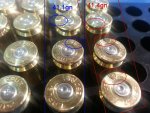Got my 260 GAP-10 a few weeks back and have finally had some time to do some OCW tests today. I found a good accuracy node, but there's some good ejector marks on the case heads. It just seems like this gun shows pressure signs with pretty light loads, or maybe I need to use a faster different powder?
I tested 139gn Scenars and H4350 at 40.2, 40.5, 40.8, 41.1, and 41.4 grains. My best load was 41.1gn at .42" at 108 yards (repeatable). You can see that that load starts to leave some brass sticking up, and its even more pronounced in the 41.4gn load. I don't see any major primer flattening. There is a little primer cratering, but it seems to do that even on very light loads anyways. I also tried a load with H4831 at 43.5gn and there are swipe marks, but no metal shavings like the H4350.
Is this just too hot? I'm pretty well of loading for bolt rifles, but this is my first big AR. I wasn't able to get chrono numbers today as the chrony wasn't working with the overcast light, but I hope to get some tomorrow.

I tested 139gn Scenars and H4350 at 40.2, 40.5, 40.8, 41.1, and 41.4 grains. My best load was 41.1gn at .42" at 108 yards (repeatable). You can see that that load starts to leave some brass sticking up, and its even more pronounced in the 41.4gn load. I don't see any major primer flattening. There is a little primer cratering, but it seems to do that even on very light loads anyways. I also tried a load with H4831 at 43.5gn and there are swipe marks, but no metal shavings like the H4350.
Is this just too hot? I'm pretty well of loading for bolt rifles, but this is my first big AR. I wasn't able to get chrono numbers today as the chrony wasn't working with the overcast light, but I hope to get some tomorrow.

Last edited:

